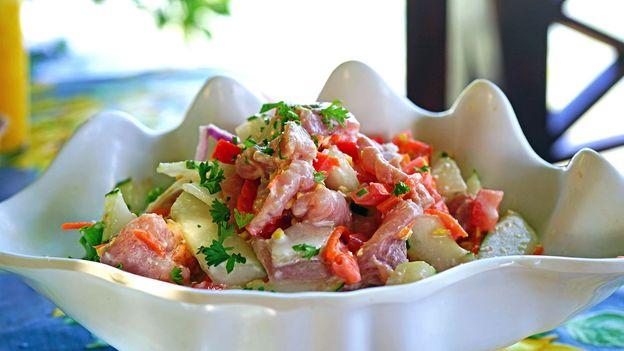If not for French explorer Louis-Antoine de Bougainville claiming Tahiti in the name of France in 1768, poisson cru, the national dish of present-day French Polynesia, might have been called by its original Polynesian name i’a ota – or ota ika as it’s known in Tonga, or even its Fijian name kokoda.
French Polynesia, which comprises more than 100 islands in the South Pacific, has had a long history with European settlers, but in the end, it’s the French who prevailed. While governed autonomously today, French Polynesia is technically an overseas territory of France, with the French language officially spoken and taught in schools – and used in many kitchens.
Poisson cru literally translates to “raw fish”, which is typically cut into bite-sized morsels, putting it in the family of Hawaiian poke and Latin American ceviche. The main difference: coconut milk. Sure, some poke and ceviche recipes may call for splashes of coconut milk, but it’s an added tweak to their foundational recipes. In the case of the Polynesian counterpart, coconut milk is very much a component of the dish’s definitive taste, the way shoyu and ponzu sauces are to many poke bowls. Like ceviche, poisson cru also calls for lime juice as an acidic “cooking” agent, and it is coconut milk that cuts the bite of the citric acid.
[jump to recipe]
The simple, pan-Polynesian raw fish salad made with a mix of vegetables is not just a meal; it’s a part of the cultural fabric in Tahiti and its surrounding islands. “This dish is an integral part of our lives,” said Taina Maiau, who runs a small business on Tahiti-adjacent Moorea, where she is the island’s first female boat captain. “We have always lived near the sea and [give] thanks to it. Coconut trees are everywhere on our islands. We can have coconut milk every day.”
Poisson cru is ubiquitous on Tahitian menus and served up at resort buffets on other islands in French Polynesia as well, like Rangiroa, Bora Bora and beyond. However, the mass preparation of this national dish in touristy resorts isn’t exactly the best version of it, according to Teuai Lenoir, a Polynesian dancer and cultural ambassador based in the Tahitian capital of Papeete.
“They prepare [poisson cru] beforehand, maybe three or four hours, and they put it in the fridge, and they serve the guests,” lamented Lenoir, who has witnessed the common kitchen practice in his previous career working on cruise ships and big resorts. “If you leave it out for one or two hours, it changes. It’s not the same taste. The fish, after two hours, will become all white. When it’s white, it’s not from the milk coconut [coconut milk]. It’s from too much lime.”
Teuai Lenoir is a Polynesian dancer and cultural ambassador based in Papeete (Credit: Stéphane-Mailion)
Lenoir is not a chef, but he knows, like any French Polynesian with any culinary skill, how to prepare his national dish. As a host to guests of Iaorana Tahiti Expeditions, his own independent tour company, he finds joy in entertaining and educating guests on ancestral traditions – one being the preparation of poisson cru.
In his rendition, the dish is only properly made when it’s prepared just before eating, with milk squeezed from freshly husked and shredded coconuts. The fish is tender, but not overcooked from too much acidic lime juice; the freshly cut vegetables are crunchy; and the aroma and colours of all the ingredients shine. “Peppers. I love putting them in the poisson cru,” he raved, speaking about green, yellow and orange bell peppers. “It makes the plate colourful, like a rainbow. When you look at a rainbow, it’s beautiful.”
When preparing poisson cru for small tour groups, Lenoir uses bright red ahi tuna, which he marinates in sea water. Not only does it bring a crimson hue to the dish – he passes on red bell peppers for this reason – but its lack of tiny bones is more palatable for Western mouths. In contrast, picking out and even sucking on fishbones were always a part of the poisson cru experience of his youth, growing up on Rurutu Island in the Austral archipelago, some 570km south of Tahiti.
Today, Lenoir serves his Western-friendly recipe family style as part of his cultural tours of Tahiti, paired with his preferred sides: boiled plantains, sweet potatoes, taro and breadfruit. Meanwhile on Moorea, Maiau’s version, which incorporates red cabbage and parsley, has a different accompaniment. “Locals love it with rice,” she said.
Regardless of any recipe tweaks, poisson cru, through its fresh ingredients, is a culinary expression of French Polynesian life, aiming to feed the souls of both locals and visitors to its islands.
Poisson cru is raw fish salad made with tuna and plenty of crisp vegetables (Credit: Stéphane Mailion)
Poisson Cru recipe By Teuai Lenoir
serves 8
1kg (2.2lb) sushi-grade ahi tuna 3 fresh coconuts (or 710ml/24oz unsweetened coconut milk from a carton, not a can) 3 bell peppers of assorted colours (green, yellow and orange), seeded and diced into 2cm (¾in) pieces 3 medium-sized tomatoes, seeded and diced into 2cm (¾in) pieces 1 long cucumber, peeled and diced into 2cm (¾in) pieces 3-4 limes 50g (3-4 tbsp) shredded carrots 50g (3-4 tbsp) chopped green onions 50g (3-4 tbsp) chopped coriander
Method
Step 1 Cut the raw ahi tuna into 2cm (¾in) cubes and marinate them in sea water for about an hour in the fridge. To simulate sea water, dissolve 35g (about 2 tbsp) of sea salt per litre of tap water.
Step 2 Husk the fresh coconuts, open them, then shred the meat into a bowl.
Step 3 Drain the tuna, then combine it in a big serving bowl with the bell peppers, tomatoes and cucumbers.
Step 4 Gather the coconut shreds into a cheesecloth and squeeze all the milk into the serving bowl. This should yield about 710ml/24oz of coconut milk. Alternatively, you can source unsweetened, store-bought coconut milk.
Step 5 Cut and squeeze the limes for their juice into the bowl. Toss the carrots, green onions and chopped coriander into the serving bowl. Mix everything and serve immediately.
BBC.com’s World’s Table “smashes the kitchen ceiling” by changing the way the world thinks about food, through the past, present and future.
—
Join more than three million BBC Travel fans by liking us on Facebook, or follow us on Twitter and Instagram.
If you liked this story, sign up for the weekly bbc.com features newsletter called “The Essential List”. A handpicked selection of stories from BBC Future, Culture, Worklife and Travel, delivered to your inbox every Friday.








